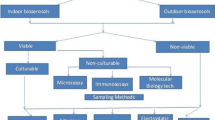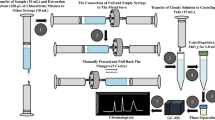Abstract
In this paper, a sample preparation method based on ultrasonic assisted acid extraction (UAE) of Al, As, Cd, Ni and Pb from filler tobacco (FT) of different local branded (LBCs) and imported branded cigarettes (IBCs) consumed in Pakistan. Acid extracts obtained upon sonication were determined by atomic absorption spectrometry. Parameters influencing extraction such as pre-sonication time 10–15 min, sonication time 2–10 min, mass of sample 0.1–0.5 g, particle size <35–125 μm and, extractant (nitric acid) concentrations (2–10%) were fully optimized to get quantitative recovery of toxic elements (TEs). The proposed method was validated with a certified reference material (CRM) Virginia tobacco leaves (ICHTJ-cta-VTL-2), and also applied a conventional acid digestion method (CDM) on same CRM, for comparative purpose. The average relative standard deviation of UAE method of CRM, ranged as 1.64–8.42% for N = 6, depending on the analytes. Extraction efficiencies for CRM were close to 97.1, 97.5, 98.5, 97.8 and 96.7 for Al, As, Cd, Ni and Pb, respectively. The concentrations of Al, As, Cd, Ni and Pb in cigarettes were present in all branded cigarettes, there is no any significance difference among LBCs and IBCs, except in few cases of LBCs, have high level of Cd and Al. Our results were compared with other worldwide studies.
Similar content being viewed by others
References
Afridi, H. I., Kazi, T. G., Arain, M. B., Jamali, M. K., Kazi, G. H., & Jalbani, N. (2007). Determination of cadmium and lead in biological samples by three ultrasonic-based samples treatment procedures followed by electrothermal atomic absorption spectrometry. Journal of AOAC International, 90, 470–478.
Amoedo, L., Capelo, J. L., Lavilla, I., & Bendicho, C. (1999). Ultrasound-assisted extraction of lead from solid samples: A new perspective on the slurry-based sample preparation methods for electrothermal atomic absorption spectrometry. Journal of Analytical Atomic Spectrometry, 14, 1221–1226.
Anderson, K. A., Magnuson, B. A., Tschirgi, M. L., & Smith, B. (1999). Determining the geographical origin of potatoes with trace metal analysis using statistical and neural network classifiers. Journal of Agricultural and Food Chemistry, 47, 1568–1575.
Arain, M. B., Kazi, T. G., Jamali, M. K., Jalbani, N., Afridi, H. I., & Shah, A. (2008). Dissolved and bioavailable elements in water and sediment samples and their accumulation in Oreochromis mossambicus of polluted Manchar Lake. Chemosphere, 70(10), 1845–1856.
Ashley, K., Andrews, R. N., Cavazos, L., & Demange, M. (2001). Ultrasonic extraction as a sample preparation technique for elemental analysis by atomic spectrometry. Journal of Analytical Atomic Spectrometry, 16, 1147–1153.
Capelo, J. L., Maduro, C., & Vilhena, C. (2005). Discussion of parameters associated with the ultrasonic solid–liquid extraction for elemental analysis (total content) by electrothermal atomic absorption spectrometry. An overview. Ultrasonics Sonochemistry, 12, 225–232.
Carpenter, D. O., Arcaro, K., & Spink, D. C. (2002). Understanding the human health effects of chemical mixtures. Environmental Health Perspectives, 110(1), 25–42.
Chang, M. J., Walker, K., McDaniel, R. L., & Connell, C. T. (2005). Impaction collection and slurry sampling for the determination of arsenic, cadmium, and lead in sidestream smoke by inductively coupled plasma-mass spectrometry. Journal of Environmental Monitoring, 7, 1349–1354.
Chepiga, T. A., Morton, M. J., Murphy, P. A., Avalos, J. T., Bombick, B. R., Doolittle, D. J., et al. (2000). Comparison the mainstream smoke chemistry and mutagenicity of a representative sample of the US cigarette market with two Kentucky reference cigarettes (K1R4F and K1R5F). Food and Chemical Toxicology, 38, 949–962.
Chiba, M., & Masironi, R. (1992). Toxic and trace elements in tobacco and tobacco smoke. Bulletin of the World Health Organization, 70, 269–275.
Coen, N., Mothersill, C., Kadhim, M., & Wright, E. G. (2001). Heavy metals of relevance to human health induce genomic instability. Journal of Pathology, 195(3), 293–299.
Demarini, D. M. (2004). Genotoxicity of tobacco smoke and tobacco smoke condensate: A review. Mutation Research, 567, 447–474.
Eisner, M. D. (2002). Environmental tobacco smoke exposure and pulmonary function among adults in NHANES III: Impact on the general population and adults with current asthma. Environmental Health Perspectives, 110, 765–770.
El Azouzi, H., Cervera, M. L., & de la Guardia, M. (1998). Multi-elemental analysis of mussel samples by atomic absorption spectrometry after room temperature sonication. Journal of Analytical Atomic Spectrometry, 13, 533–538.
Eyre, H., Kahn, R., Robertson, R. M., Clark, N. G., Doyle, C., Gansler, T., et al. (2004). Preventing cancer, cardiovascular disease, and diabetes: A common agenda for the American Cancer Society, the American Diabetes Association, and the American Heart Association. CA: A Cancer Journal For Clinicians, 54, 190–207.
Filgueiras, A. V., Capelo, J. L., Lavilla, I., & Bendicho, C. (2000). Comparison of ultrasound-assisted extraction and microwave-assisted digestion for determination of magnesium, manganese and zinc in plant samples by flame atomic absorption spectrometry. Talanta, 53, 433–441.
Fowles, J., & Dybing, B. (2003). Application of toxicological risk assessment principles to the chemical constituents of tobacco smoke. Tobacco Control, 12, 424–430.
Gairola, C. G., & Wagner, G. J. (1991). Cadmium accumulation in the lung, liver, and kidney of mice and rats chronically exposed to cigarette smoke. Journal of Applied Toxicology, 11, 355–358.
Goyer, R. A. (1996). Toxic effects of metals. In C. D. Klaassen (Ed.), Casarett and Doull’s toxicology: The basic science of poisons (5th ed., pp. 691–736). New York: McGraw-Hill.
Gutteridge, J. M. C., Quilan, G. J., Clarke, I., & Halliwell, B. (1985). Aluminum salts accelerate peroxidation of membrane lipids stimulated by iron salts. Biochimica et Biophysica Acta, 835, 441–447.
Hecht, S. S. (2003). Tobacco carcinogens, their biomarkers and tobacco induced cancer. Nature Reviews. Cancer, 3, 733–744.
Husgavfel-Pursiainen, K. (2004). Genotoxicity of environmental tobacco smoke: A review. Mutation Research, 567, 427–445.
Jin, Y. H., Clark, A. B., Slebos, R. J. C., Al-Refai, H., Taylor, J. A., Kunkel, T. A., et al. (2003). Cadmium is a mutagen that acts by inhibiting mismatch repair. Nature Genetics, 34, 326–329.
Johnston, H. B., Thomas, S. M., & Atterwill, C. K. (1993). Aluminum and iron induced metabolic changes in neuroblastoma cell lines and rat primary neural cultures. Toxicology In Vitro, 7, 229–233.
Jung, M. C., Thornton, I., & Chon, H. T. (1998). Arsenic, cadmium, copper, lead, and zinc concentrations in cigarettes produced in Korea and the United Kingdom. Environmental Technology, 19(2), 237–241.
Júnior, D., Francisco, J. K., Pereira, M., & Korn, M. (2006). Currents on ultrasound-assisted extraction for sample preparation and spectroscopic analytes determination. Applied Spectroscopy Reviews, 41, 305–321.
Kazi, T. G., Afridi, H. I., Kazi, G. H., Jamali, M. K., Arain, M. B., & Jalbani, N. (2006). Evaluation of essential and toxic metals by ultrasound-assisted acid leaching from scalp hair samples of children with macular degeneration patients. Clinica Chimica Acta, 369, 52–60.
Kingston, H. M., & Haswell S. J. (Eds.) (1997). Microwave-enhanced chemistry. Washington, DC: American Chemical Society.
Landsberger, S., & Wu, S. (1995). The impact of heavy metals from environmental tobacco smoke on indoor air quality as determined by Compton suppression neutron activation analysis. Science of the Total Environment, 173–174, 323–337.
Lavilla, I., Perez Cid, B., & Bendicho, C. (1998). Leaching of heavy metals from an aquatic plant (Lagarosiphon major) used as environmental biomonitor by ultrasonic extraction. International Journal of Environmental Analytical Chemistry, 72, 47–57.
Lugon-Moulin, N., Martin, F., Krauss, M. R., Ramey, P. B., & Rossi, L. (2006). Cadmium concentration in tobacco (Nicotiana tabacum L.) from different countries and its relationship with other elements. Chemosphere, 63, 1074–1086.
Mannino, D. M., Albalak, R., Grosse, S., & Repace, J. (2003). Second-hand smoke exposure and blood lead levels in US children. Epidemiology, 14, 719–727.
Mason, T. J. (1991). Practical sonochemistry. User’s guide to applications in chemistry and chemical engineering (1st ed., ch. 1). Chichester: Ellis Horwood.
Mason, T. J. (Ed.) (1999). Sonochemistry. New York: Oxford University Press.
Massadeh, A. M., Alali, F. Q., & Jaradat, Q. M. (2005). Determination of cadmium and lead in different cigarette brands in Jordan. Environmental Monitoring and Assessment, 104, 163–170.
Mulchi, C. L., Adamu, C. A., Bell, P. F., & Chaney, R. L. (1992). Residual heavy metal levels in sludge amended coastal plain soils – II. Predicting metal levels in tobacco from soil test information. Communications in Soil Science and Plant Analysis, 23, 1053–1069.
Navas-Acien, A., Selvin, E., Sharrett, A. R., Calderon-Aranda, E., Silbergeld, E., & Guallar, E. (2004). Lead, cadmium, smoking, and increased risk of peripheral arterial disease. Circulation, 109, 3196–3201.
Priego-Capote, F., & Luque de Castro, M. D. (2007). Ultrasound-assisted digestion: A useful alternative in sample preparation. Journal of Biochemical and Biophysical Methods, 70, 299–310.
Rickert, W. S., & Kaiserman, M. J. (1994). Levels of lead, cadmium, and mercury in Canadian cigarette tobacco as indicators of environmental changes Results from a 21-year study (1968–1988). Environmental Science & Technology, 28(5), 924–927.
Rosen, B. P. (1995). Resistant mechanisms to arsenicals and antimonials. Journal of Basic & Clinical Physiology & Pharmacology, 6, 251–264.
Rustemeier, K., Stabbert, R., Haussman, H. J., Roemer, E., & Carmines, E. L. (2002). Evaluation of the potential effects of ingredients added to cigarettes. Part 2: Chemical composition of mainstream smoke. Food and Chemical Toxicology, 40, 93–104.
Savory, J., Exley, C., Forbes, W. F., Huang, Y., Joshi, J. G., Kruck, T., et al. (1996). Can the controversy of the role of aluminum in Alzheimer’s disease be resolved? What are the suggested approaches to this controversy and methodological issues to be considered. Journal of Toxicology and Environmental Health, 48, 615–635.
Schwartz, R. S., & Hecking, L. T. (1991). Determination of geographic origin of agricultural products by multivariate analysis of trace metal composition. Journal of Analytical Atomic Spectrometry, 6, 637–642.
Semu, E., & Singh, B. R. (1995). Accumulation of heavy metals in soils and plants after long- term use of fertilizers and fungicides in Tanzania. Fertilizer Research, 44(3), 241–248.
Shaham, J., Meltzer, A., Ashkenazi, P., & Ribak, J. (1996). Biological monitoring of exposure to Cd, a human carcinogen, as a result of active and passive smoking’. Journal of Occupational and Environmental Medicine, 38, 1220–1228.
Soylak, M., Tuzen, M., Narin, I., & Sari, H. (2004). Comparison of microwave, dry and wet digestion procedures for the determination of trace metal contents in spice samples produced in Turkey. Journal of Food and Drug Analysis, 12, 254–258.
Stohs, S. J., & Bagchi, D. (1995). Oxidative mechanisms in the toxicity of metal ions. Free Radical Biology & Medicine, 18, 321–336.
Stohs, S. J., Bagchi, D., & Bagchi, M. (1997). Toxicity of trace elements in tobacco smoke. Inhalation Toxicology, 9, 867–890.
Tian, L., & Lawrence, D. A. (1996). Metal-induced modulation of nitric oxide production in vitro by murine macrophages: Lead, nickel and cobalt utilize different mechanisms. Toxicology and Applied Pharmacology, 141, 540–547.
Tsadilas, C. D., & Soilp, H. (2000). Influence on cadmium uptake by tobacco in high cadmium exposure. Journal of Plant Nutrition, 23(8), 1167–1178.
Tuzen, M., Sari, H., & Soylak, M. (2004). Microwave and wet digestion procedures for atomic absorption spectrometric determination of trace metals contents of sediment samples. Analytical Letters, 37, 1925–1936.
Wagner, K. A., McDaniel, R., & Self, D. (2001). Collection and preparation of sidestream cigarette smoke for trace elemental determinations by graphite furnace atomic absorption spectrometry and inductively coupled plasma mass spectrometry. Journal of AOAC International, 84, 1934–1940.
Wu, D., Landsberger, S., & Larson, S. M. (1997). Determination of the elemental distribution in cigarette components and smoke by instrumental neutron activation analysis. Journal of Radioanalytical and Nuclear Chemistry, 217(1), 77–82.
Xiao, T., Guha, J., Boyle, D., Liu, C. Q., & Chen, J. (2004). Environmental concerns related to high thallium levels in soils and thallium uptake by plants in southwest Guizhou, China. Science of the Total Environment, 318, 223–244.
Zaman, K., & Pardini, R. S. (1996). An overview of the relationship between oxidative stress and mercury and arsenic. Toxic Substance Mechanisms, 15, 151–181.
Author information
Authors and Affiliations
Corresponding author
Rights and permissions
About this article
Cite this article
Kazi, T.G., Jalbani, N., Arain, M.B. et al. Determination of toxic elements in different brands of cigarette by atomic absorption spectrometry using ultrasonic assisted acid digestion. Environ Monit Assess 154, 155–167 (2009). https://doi.org/10.1007/s10661-008-0386-3
Received:
Accepted:
Published:
Issue Date:
DOI: https://doi.org/10.1007/s10661-008-0386-3




